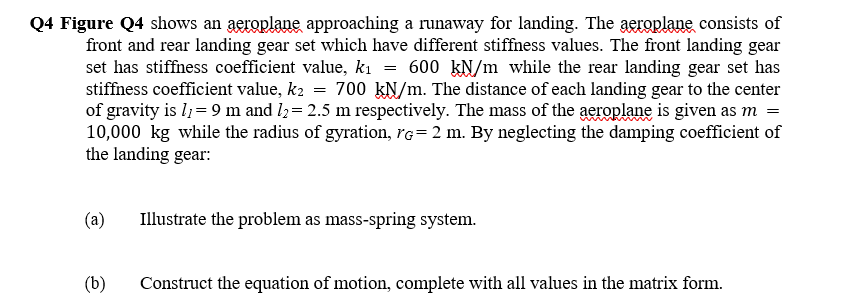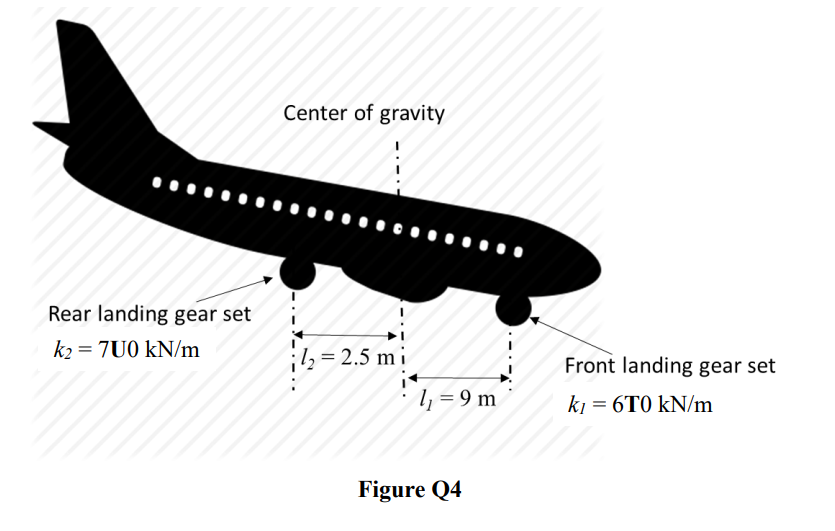Q4 Figure Q4 shows an aeroplane approaching a runaway for landing. The aeroplane consists of front and rear landing gear set which have different stiffness values. The front landing gear set has stiffness coefficient value, kı = 600 kN/m while the rear landing gear set has stiffness coefficient value, k2 = 700 kN/m. The distance of each landing gear to the center of gravity is l; = 9 m and I2= 2.5 m respectively. The mass of the aeroplane is given as m = 10,000 kg while the radius of gyration, rG= 2 m. By neglecting the damping coefficient of the landing gear: (a) Illustrate the problem as mass-spring system. (b) Construct the equation of motion, complete with all values in the matrix form.
Q4 Figure Q4 shows an aeroplane approaching a runaway for landing. The aeroplane consists of front and rear landing gear set which have different stiffness values. The front landing gear set has stiffness coefficient value, kı = 600 kN/m while the rear landing gear set has stiffness coefficient value, k2 = 700 kN/m. The distance of each landing gear to the center of gravity is l; = 9 m and I2= 2.5 m respectively. The mass of the aeroplane is given as m = 10,000 kg while the radius of gyration, rG= 2 m. By neglecting the damping coefficient of the landing gear: (a) Illustrate the problem as mass-spring system. (b) Construct the equation of motion, complete with all values in the matrix form.
Elements Of Electromagnetics
7th Edition
ISBN:9780190698614
Author:Sadiku, Matthew N. O.
Publisher:Sadiku, Matthew N. O.
ChapterMA: Math Assessment
Section: Chapter Questions
Problem 1.1MA
Related questions
Question

Transcribed Image Text:Q4 Figure Q4 shows an aeroplane approaching a runaway for landing. The aeroplane consists of
front and rear landing gear set which have different stiffness values. The front landing gear
set has stiffness coefficient value, kı = 600 kN/m while the rear landing gear set has
stiffness coefficient value, k2 = 700 kN/m. The distance of each landing gear to the center
of gravity is l; = 9 m and I2= 2.5 m respectively. The mass of the aeroplane is given as m =
10,000 kg while the radius of gyration, rG= 2 m. By neglecting the damping coefficient of
the landing gear:
(a)
Illustrate the problem as mass-spring system.
(b)
Construct the equation of motion, complete with all values in the matrix form.

Transcribed Image Text:Center of gravity
Rear landing gear set
k2 = 7U0 kN/m
1, = 2.5 m i
Front landing gear set
· I, = 9 m
kj = 6T0 kN/m
Figure Q4
Expert Solution
This question has been solved!
Explore an expertly crafted, step-by-step solution for a thorough understanding of key concepts.
Step by step
Solved in 2 steps with 2 images

Knowledge Booster
Learn more about
Need a deep-dive on the concept behind this application? Look no further. Learn more about this topic, mechanical-engineering and related others by exploring similar questions and additional content below.Recommended textbooks for you

Elements Of Electromagnetics
Mechanical Engineering
ISBN:
9780190698614
Author:
Sadiku, Matthew N. O.
Publisher:
Oxford University Press

Mechanics of Materials (10th Edition)
Mechanical Engineering
ISBN:
9780134319650
Author:
Russell C. Hibbeler
Publisher:
PEARSON

Thermodynamics: An Engineering Approach
Mechanical Engineering
ISBN:
9781259822674
Author:
Yunus A. Cengel Dr., Michael A. Boles
Publisher:
McGraw-Hill Education

Elements Of Electromagnetics
Mechanical Engineering
ISBN:
9780190698614
Author:
Sadiku, Matthew N. O.
Publisher:
Oxford University Press

Mechanics of Materials (10th Edition)
Mechanical Engineering
ISBN:
9780134319650
Author:
Russell C. Hibbeler
Publisher:
PEARSON

Thermodynamics: An Engineering Approach
Mechanical Engineering
ISBN:
9781259822674
Author:
Yunus A. Cengel Dr., Michael A. Boles
Publisher:
McGraw-Hill Education

Control Systems Engineering
Mechanical Engineering
ISBN:
9781118170519
Author:
Norman S. Nise
Publisher:
WILEY

Mechanics of Materials (MindTap Course List)
Mechanical Engineering
ISBN:
9781337093347
Author:
Barry J. Goodno, James M. Gere
Publisher:
Cengage Learning

Engineering Mechanics: Statics
Mechanical Engineering
ISBN:
9781118807330
Author:
James L. Meriam, L. G. Kraige, J. N. Bolton
Publisher:
WILEY